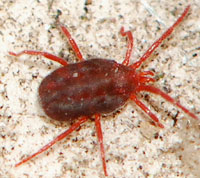Disinfect to kill red mites

Red mite infestations are costing the EU egg industry an estimated 38p a hen – equivalent to £114m each year – and effective control can only be achieved by breaking the cycle of re-infection.
Red mite are one of the most difficult pests for the poultry farmer to control, says Jim Bigmore, managing director of animal health company Hysolv.
“The hunt for the next successful pesticide is a never-ending treadmill for the agrochemical companies. Unfortunately, there is a relatively short time between the launch of a new ‘ground-breaking’ product and the development of resistance.”
When a pesticide is used in a layer house, not all the red mite may be killed. Any surviving mites will then lay eggs which grow into adult mites having the same resistance qualities as their parents. The process continues until, eventually, the majority of the red mite colony is resistant to the particular product being used.
But the cycle of resistance can be broken by using an effective anti-mite disinfectant during the end-of-cycle clean-out, says Mr Bigmore, though it is important to use a disinfectant which is effective against mite eggs as well as the remaining mites.
“This means that, even though the next crop of birds will still be exposed to non-resistant mites coming into the house from outside, the colony of resistant mites within the house will be removed at the end of every cycle.
Mr Bigmore suggests that disinfectants, such as Hysolv’s Interkokask, can overcome the problem of resistance to pesticides, because it dissolves the outer cell membrane – a process which can’t be resisted by the mites.
